Work Smarter Not Harder With Compound Exercises
Our content strives to support, inform, and motivate you to meet your health goals. We want to be your trusted source of expert- and science-backed info dispensed in simple, actionable ways. Read our Editorial Guidelines.
Getting fit is definitely a priority for most of us. But, so is getting enough sleep, feeding ourselves, showering, working for a living, taking the kids to karate, picking up the dog from the groomer, calling our mom, going to our best friend’s birthday party, (*gasps for air*) cleaning the house, shopping for groceries, stopping by the pharmacy — you get the idea.
We’ve all got fitness goals, but we’ve also got busy lives. So, we need our workout routines to be efficient. We need compound exercises.
Compared to other strength training exercises, these all-in-one exercises can help us get fit in less time by targeting multiple muscle groups and allowing us to check both cardio and strength training off our to-do list at once.
Learn how compound exercises work and how they can help you meet your fitness goals. Then, discover our favorite exercises that you can do at home with exactly zero workout equipment.
What Are Compound Exercises?

There are two types of exercises in this world, just like how there are two types of people: Those who already know the two types of exercises, and those who are about to find out!
The first type of exercises are called compound exercises (but maybe you already deduced that from the title of this article). The second type is called isolation exercises. Isolation exercises are essentially the opposite of compound exercises.
Compound exercises target multiple muscle groups at the same time. They’re also called multi-joint exercises or compound movements. These exercises mirror our bodies’ natural movement because in most of our day-to-day activities — from bringing in groceries to moving the coffee table — we use multiple muscles at the same time. Many compound exercises will be familiar from your middle school P.E. class — think pull-ups, chin-ups, and push-ups.
Isolation exercises target a single muscle group. They’re sometimes called single-joint exercises or isolation movements. Targeting a specific muscle group can help fix a strength imbalance — like when you’ve been skipping leg day or need to regain strength after an injury. Examples of these include: bicep curls, hamstring curls, and chest flys.
The Benefits of Compound Exercises

More benefits, less time — that’s the glory of compound exercises!
Compound exercises are so efficient that they form the basis of the 7-minute scientific workout (a little workout routine that got a lot of attention a few years back). The scientifically proven idea behind the 7-minute workout was that you could build muscle mass and improve your heart rate in just seven minutes, as long as you chose the right exercises. And those exercises just happened to be compound exercises.
While the 7-minute workout called for specific exercises done in a specific order, more recent research has proven that nearly any short workout can have big benefits. And when you incorporate these exercises into your (even very short) routine, it will compound your workout benefits. Here are our favorite benefits of compound exercises:
Embrace functional fitness: One of the reasons compound exercises are so effective is because they’re based on the seven primal movements, which are pull, push, squat, lunge, hinge, rotation, and gait. These are the basic movements that all of us use every day. By practicing them as part of your workout routine, you’ll make your daily activities easier.
Increase your motivation: Even if you only have a small amount of time, compound exercises can help you make small wins, like building strength or feeling more energetic. These small wins increase your fitness motivation, which can encourage you to stick with and build onto your workout routine.
Decrease your risk of injury: Just ask new parents, and they’ll tell you that it’s easy to get a repetitive use injury just from going about your day (lifting your little tyke or chasing them around the playground). When you practice movements like squatting, pushing, and pulling as part of your fitness routine, you create a muscle memory that helps you perform these tasks safely and with the proper form every time you need them.
Squeeze in some cardio: Compound exercises do more than promote muscle growth — they’re also great for your cardiovascular fitness because engaging more muscles causes your heart rate to go up. To get the most cardio benefits, push yourself to do your exercises fast enough that it becomes difficult to sing during your exercise routine. (Bonus: This is the perfect excuse to belt out your favorite song while you work out.)
The Best Compound Exercises to Add to Your At-Home Workout Routine
Now that we’ve recruited you to our compound exercises fan club, we’ve rounded up five of our favorite compound movements to make your workout amazing.
There are plenty of compound lifts you can do at the gym — barbell bench presses, deadlifts, shoulder presses, kettlebell swings, dumbbell exercises, the list goes on — but we’re specifically focusing on bodyweight exercises. Everything in this list is easy to do at home without workout equipment.
To start, try doing three sets of 10 reps each. As that starts to feel easier, you can add more sets or more reps in each set.
While we’ll give you the information you need to get started, we recommend consulting with a personal trainer to make sure you’re doing each exercise correctly. Proper form is key to preventing injuries.
1. Squats
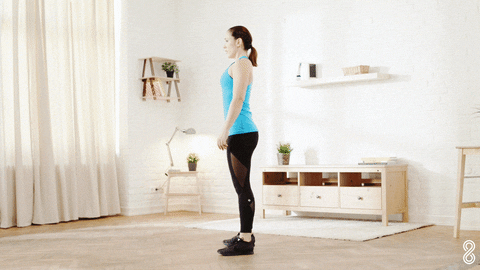
Muscles targeted: gluteus maximus (glutes), hip flexors, quadriceps (quads), lower back, abdominal muscles (abs), calves, and hamstrings
Do it: Squats sound easy, but to do this lower body exercise safely, you need to use proper alignment. Here’s how:
Stand with your feet a little wider than hip-width apart.
Turn your toes out just a little bit.
Tighten your abdominal muscles.
Shift your weight to your heels.
Lower your hips down while keeping your core tight and your chest lifted.
Continue lowering until your quads are nearly parallel to the floor.
Raise yourself back up to a standing position while keeping your core tight and chest lifted.
Make it harder: When you stand back up, add a jump by pushing off the floor with your feet. Congratulations, you just did a jump squat!
Make it easier: Hey, there’s no shame in your game! If you need to make this move easier, try only squatting half way instead of taking your thighs parallel to the floor, or hold onto a stable support (like a table, bed frame, or sturdy chair) as you do your squat.
2. Lunges
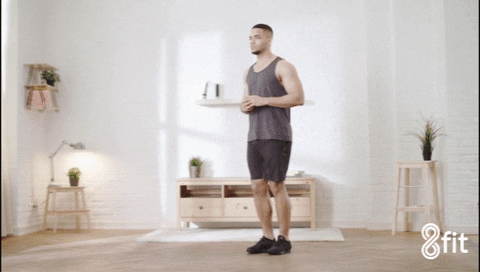
Muscles targeted: glutes, hamstrings, quads, calves, abs, obliques, and erector spinae
Do it: Lunges are a great way to strengthen your posterior chain (no one wants an inferior posterior!). To do them safely:
Stand with your feet hip-width apart and your hips facing forward. This is your starting position.
Step your left foot forward, slightly farther than you would if you were walking.
Tighten your core muscles, and keep your chest up.
Bend your knees as you lower your hips toward the ground.
Keep lowering until your front quad is nearly parallel to the ground.
Make sure your feet stay flat on the ground and your front knee stays behind your toes throughout the entire movement. Your back knee should never touch the ground.
Raise yourself back up while keeping your core tight and your chest up.
Step your left foot back to return to your starting position.
Repeat the exercise on the other side by stepping your right foot forward.
Make it harder: Hold weights in both hands as you lunge. If you don’t have hand weights, you can hold a heavy household item like weighty books or old gallon milk jugs filled with water. Keep your arms down by your side and lunge as usual. Still not hard enough? Lunges are clearly your superpower. Try adding progressively heavier weights or adding a bicep curl when you reach the bottom of your lunge.
Make it easier: Only do half a lunge instead of trying to get that front thigh completely parallel to the ground. Or, try a static lunge. Skip the step forward and step back at the beginning and end of the move. Instead, place one foot forward like you’ve just taken a big step and use that as your starting position. Lunge up and down 10 times, keeping your feet in place. Switch legs so the opposite leg is in front, and repeat the 10 lunges on the other side.
3. Tricep Dips
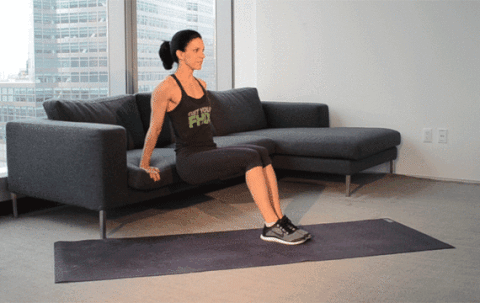
Muscles targeted: triceps, pecs, traps, and upper back
Do it: This challenging exercise is a great upper body workout, but it can lead to shoulder injuries if you don’t do it properly. If you’re still building your upper body strength, start with the easier variation. Here’s how to do a traditional tricep dip:
Find a stable, raised surface that can support your weight. The side of your bed, your couch, or a sturdy chair work well. For ease of explanation, we’ll pretend you’re going to use a chair.
Sit on the edge of the chair and place your hands behind you, shoulder-width apart.
Grip the sides of the chair with both hands and slide your butt forward, off the front of the chair, so now you are supporting your weight with your arms. This is your starting position.
Bend your elbows to lower your body down toward the floor, keeping your chest up throughout the movement.
Keep bending until your elbows are at a 90-degree (or slightly larger) angle. Don’t go past a 90-degree bend.
Push yourself back up to your starting position, being careful not to lock your elbows at the top of the position.
Make it harder: We’re not sure why you would want to do this to yourself, but if you insist ... place a heavy object in your lap to add more resistance to this position. If you have young kids, you can have them sit in your lap to make this a family affair. A large book is also a good choice. As the movement becomes easier, add heavier and heavier loads. If you’re using your kids for resistance, they’ll automatically get heavier as they grow — such good little helpers!
Make it easier: Give yourself extra support by keeping both feet planted firmly on the floor. Bend your knees as you lower yourself down with your arms. When you get to the bottom of your tricep dip, use your legs to push yourself back up to your starting position.
4. Push-Ups
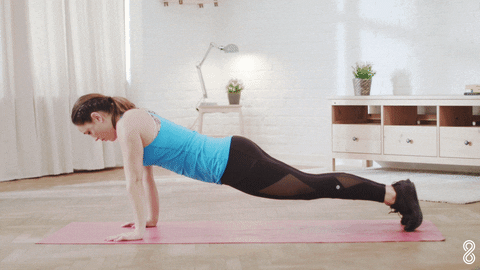
Muscles targeted: pecs, deltoids, triceps, abs
Do it: Since we all learn this one in P.E., you’d think we’d all be experts. But bad form is common here. The most common mistake people make is arching their back instead of keeping their core tight. This can lead to lower back injuries. So, if you’re struggling to keep your abdominal muscles tight throughout the entire movement, try an easier variation. Here’s how to do a traditional push-up:
For your starting position, you’ll be in a plank pose with your hands slightly wider than shoulder-width apart.
Tighten your core.
Squeeze your glutes to support your core muscles and help them remain tight throughout the pose.
Lower your body toward the ground by bending your elbows. Elbows should point backwards, not out to the sides, as you lower.
Keep lowering until your chest touches or hovers just above the ground.
Straighten your elbows to return to your starting position, being careful not to lock your elbows at the top of the position.
Make it harder: Try a decline push-up by placing your feet on an elevated surface like the edge of your couch or the bottom step on a flight of stairs. You’ll perform the push-up as usual, just with your feet elevated. This shifts more weight toward your chest and shoulders, adding more resistance to the exercise.
Make it easier: Rest your knees on the ground, and do the rest of the push-up as usual, keeping your core tight throughout. You may also remember this modified push-up from P.E. Once problematically referred to as “girl push-ups,” this modification is a good strength training exercise for anyone who is building their upper body strength, and starting from this modified position can help you avoid injuries — a smart choice for men and women alike.
5. Step-Ups
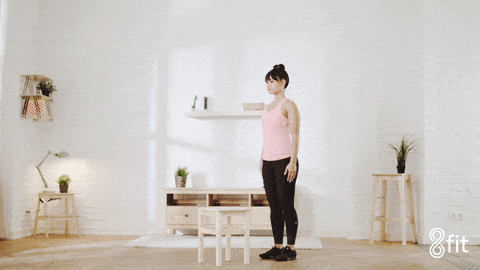
Muscles targeted: quads, glutes, and hamstrings
Do it: This lower body exercise is an easy natural movement, but, as with all these exercises, the key is to keep your core tight. You’ll need a sturdy surface to step up onto, whether that’s your stairs, your couch, or a bench. To start:
Stand facing the step.
Keep your abdominal muscles and glutes tight.
Lift your chest and roll your shoulders back and down. You’re now in your starting position.
Lift your left leg up onto the step in front of you so that your knee is bent at around a 90-degree angle.
Use your left leg to press yourself up so that you are standing on the step.
Don’t place your right foot on the step until your left leg is straight. Be careful not to lock your left knee.
Take your right foot off the step and use your left leg to lower yourself back down.
Once your right foot is firmly planted on the ground, lower your left leg and return to your starting position.
Repeat the exercise on the right side.
Make it harder: Hold weights or heavy household objects (those milk jugs from your lunges will come in handy) in both hands. Keep your arms down by your sides while you perform the movement.
Make it easier: Instead of choosing a step that allows you to bend your knee to a 90-degree angle, choose a lower step. Try the exercise using the first step on your staircase, a wooden crate, or a one-step ladder.
Compound Your Efforts With Coaching

Compound exercises target multiple muscle groups at once, which can help you get fit in less time. You can simultaneously build strength and improve your cardiovascular fitness. (We love multitasking!) Plus, these exercises are based on functional fitness, mirroring the movements we all use on a daily basis, so they can help you avoid injuries in your daily life.
Our five favorite compound exercises — squats, lunges, tricep dips, push-ups, and step-ups — are a good place to start, but if you want to get a personalized workout routine, fill out this form to talk to a fitness coach for free. A coach or personal trainer can help you choose the compound exercises that fit with your fitness goals.
Plus, coaches can check your form to make sure you’re doing each exercise correctly, which can help you prevent injury and stay active for years to come. And they’ll serve as an accountability partner, helping you stay on track. They’re basically the really active friend you wish you had.
Find the best fitness buddy ever with Kickoff!